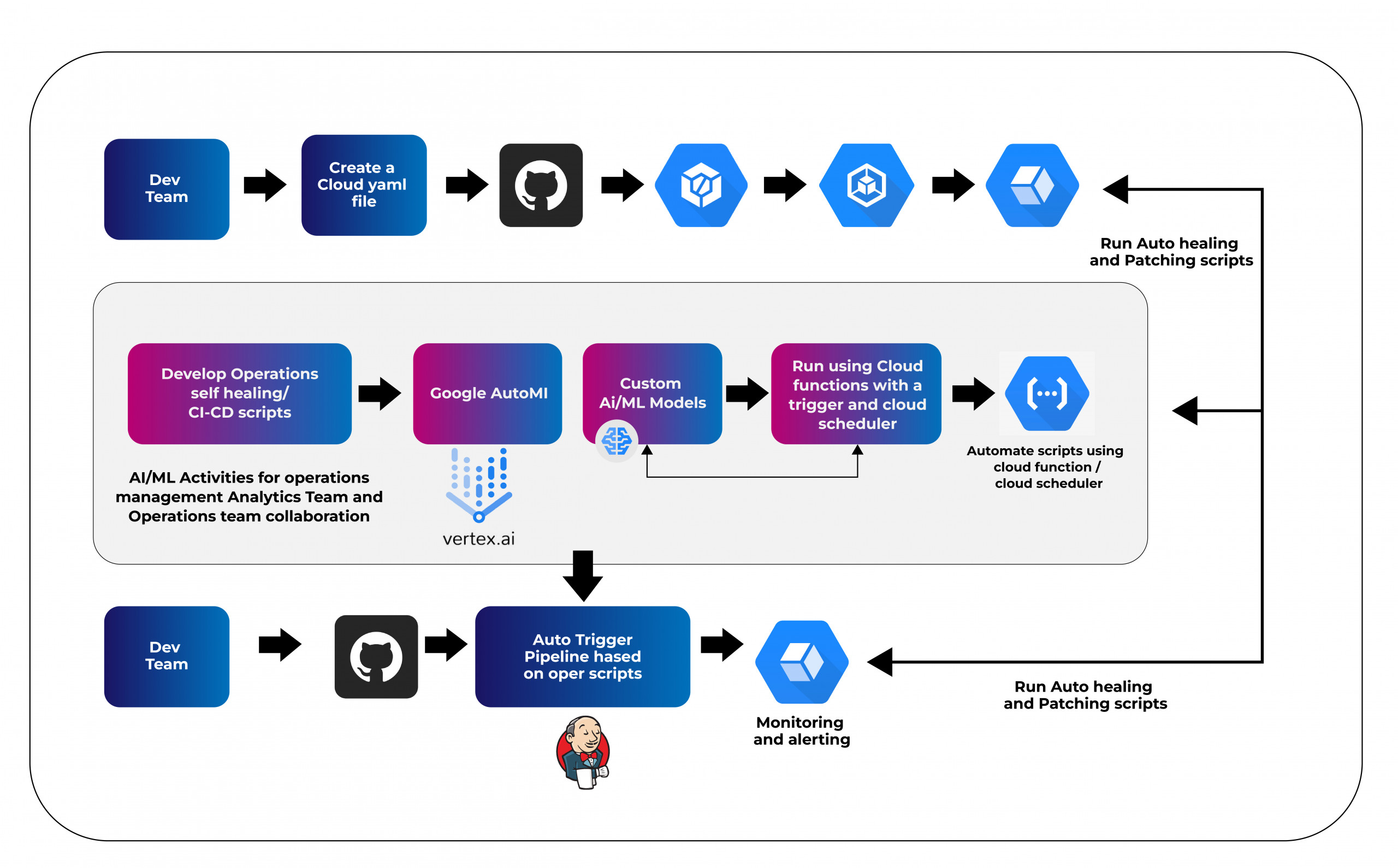INTRODUCTION
No-Ops or ZeroOps is a way of working, an idea that states that the software environment can be completely automated and there is no need for an operations team. In this Point of View document, we will be looking at the distinguishing features of NoOps with DevOps along with its benefits and disadvantages.
Our point of view emphasizes on when and how the NoOps/ZeroOps way of working could be adopted detailing specific approaches. We will also talk about the cultural change that an organization needs to adopt to achieve this.
DevOps
DevOps being the prime force in ensuring quicker time to market for an organization, has become a prime goal for every organization in the current competitive scenario. DevOps practices serve as an aid to automate SDLC and ensure quality applications are shipped through.
The majority of organizations across the globe are adopting matured DevOps Engineering practices.
What is Next?
The answer to the above question could be a focused goal for all organizations in the future with fully matured DevOps practices.
A Step Ahead of DevOps
To take a step further and reduce the involvement of the operations team, there needs to be a process that would automate every aspect of the software development life cycle once the team completes the development. This journey is No-Ops (No Operations).
By reducing the involvement of the operations team in development/deployment tasks, enhanced focus can be given to infrastructure monitoring and maintenance. This would ensure premier services to all the customers, which would in turn help in building the organization reputation globally.
DevOps vs NoOps
We will now explore all the changes that can be seen between DevOps and NoOps / ZeroOps
DevOps

The above diagram is an example of a DevOps approach that emphasizes the need for a support and operations team for managing Go-Live activities. Patching and Infrastructure management also play a pivotal part which is also handled by the above two teams.
So how is NoOps/ZeroOps different?
NoOps/ZeroOps
NoOps/ZeroOps theoretically means no operations, but the practicality of implementing this is extremely difficult. This actually means reduction of operation and support activities management by using serverless offerings.
We will be looking at a couple of approaches for accomplishing this.

AI and machine learning play a crucial role in implementing the NoOps Approach, as seen in the above diagram the focus is on building Artificial Intelligence/Machine Learning (AI/ML) capabilities for reducing the overhead of the operations teams.
This can help channel the Ops/Support Team activities in areas of high priority/improvement/innovative areas of the technology function. The focus would shift to identifying patterns of application behavior, which will lead to the enhancement of existing infra and resources used for building and deploying the application. This will improve the quality and speed of the delivery.
This approach is not a complete NoOps/ZeroOps solution but a matured step ahead of DevOps.
How does one build the road to implement NoOps/ZeroOps?
NoOps/ZeroOps Implementation
The NoOps/ZeroOps example seen above is a challenging path as there are several areas that may require a team to manage, such as:
- Regulatory Compliance
- Improved Business Intelligence
- Edge Computing
- High Priority Issues
- Complex Changes
We can infer that the need for lean operations/support teams is inevitable, but NoOps/ZeroOps, when leveraged, can help in shifting the focus of the teams towards these key activities only.
The journey of NoOps/ZeroOps may come with its own set of challenges.
Embracing Change
No-Ops/ZeroOps, as stated earlier, is a step ahead of DevOps, this does not mean embracing NoOps/ZeroOps would be an easier journey for organizations that have already adopted DevOps.
NoOps/ZeroOps adoption would be a challenging path and every organization desiring to achieve this stage should embrace the challenges and associated risks while planning its implementation journey.
Operations teams are required to adapt the new ways of working and emphasize more on the business intelligence side for serving its end customers in the best possible way. These would, in turn, require upskilling the Ops/Support teams and help them prioritize each activity.
NoOps would enable the Ops and support team to identify gaps or potential downtimes upfront and devise a plan and strategy to mitigate the risk.
The organization also needs to define proper KPIs (Key performance indicators) that will validate the progress and help in decision-making during the transformation journey.
With the majority of organizations adopting the cloud, we have taken into consideration a NoOps/ZeroOps implementation example using Google Cloud (GCP).
An Example Approach

This example showcases a NoOps/ZeroOps pipeline that can be designed leveraging Google Cloud services.
Organizations Opting for Managed Services from a Public Cloud Provider
This approach is suitable for a customer who has not adopted DevOps and wants to directly implement NoOps/ZeroOps practices.
GCP Cloud build – Cloud build is a serverless offering from Google Cloud. The advantage is that there is no need to manage servers or infrastructure.
Organizations can focus on application development and then mention a configuration which states how to release the application. The serverless offering will take the config as the input and create a release for the application. Maintenance and Patches are the responsibility of the cloud provider.
The configuration file is in a yaml format that defines steps for application release. Entire management of infra and maintenance efforts will be saved and these can be utilized into identifying application and customer behavior, which is used in fine-tuning the application.
GCP Cloud monitoring– Another important part is monitoring of the application. This activity can be auto-managed using monitoring offerings of the cloud provider. Auto-alerting and healing scripts can be defined that get triggered based on threshold violation.
This setup can help the operations and support team to focus more on high-priority or complex problems and correspondingly develop scripts for handling these problems automatically in the future.
Organizations Opting for Their Own Open-Source Tools and Public Cloud Services
This is suitable for an organization where DevOps practices are implemented and they desire to move towards implementing NoOps Practices for better efficiency and utilization of operations and support team.
The challenge would be to integrate NoOps practices with the existing tooling of the organization. AI service offerings will be considered for accomplishing this.
Cloud Functions:. Operations Team can build utility scripts for various operating tasks that can be run as a part of a serverless offering of a public cloud service (Cloud Functions).
The operations team can work closely with ML Architects to build self-healing and self-patching scripts that will be run as and when required.
These models can be matured as more and more insights are gained regarding user and application behavior.
Cloud Scheduler –
There can be schedules defined for recurring non-changing processes. This will reduce the operations team’s effort in performing this activity.
The above given approach is an example that can serve as an aid to organizations wishing to upgrade to NoOps practices.
Challenges/Disadvantages
- Edge Computing and Business intelligence can prove to be expensive if not efficiently managed as AI/ML Models generate more traffic if not frequently upgraded.
- Regulatory Compliance needs manual intervention and cannot be fully automated with NoOps/ZeroOps Practices.
- Cultural changes might be required for adopting the NoOps/ZeroOps way of working.
Advantages
- Reduced Manual intervention.
- Entire Infra is managed using NoOps/ZeroOps practices involving AI which enables more robust and efficient environments that would boost user experience.
- Self-healing scripts are designed and upgraded regularly for improving application resiliency.
- The Operations Team can focus more on application and user behavior and develop scripts and models for catering to different users across the globe and provide premium customer service.
- Better collaboration of AI/ML and Data Science teams with Operations and support teams to ensure different user requirements are catered to.
NoOps/ZeroOps is the Way Forward
Moving to No-Ops/ZeroOps isn’t easy, but given the benefits of having a better customer experience and satisfaction, it can be a driving factor for organizations to adopt NoOps. This would enable them to grow faster and ensure customer-serving applications are highly available and scalable. For organizations wishing to move faster, NoOps is definitely worth a try.





